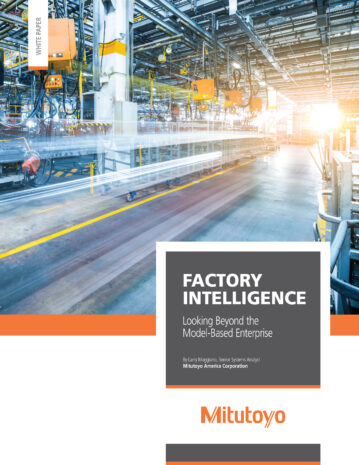 First came smart people. They made machines. Over time, machines got smarter — and so did people.
First came smart people. They made machines. Over time, machines got smarter — and so did people.
Today’s factory intelligence is the collaborative orchestration of people and machines. By blending intelligence from multiple sources, factories are truly becoming smarter. But it’s not just about the machines. Rather, people are improving machines through a true partnership that turns human experience into smarter machines.
This shift marks a re-orientation to a thought process that’s more natural to people. After decades of working with 2D blueprints, designs and dimensioned drawings, factory intelligence leverages 3D models that are easier for people to comprehend and use. Plus, many people find more satisfaction in intelligent factory work that challenges them to manage relationships among machines, rather than repeatedly working on a single piece in a line. In smarter factories, people direct machines to adjust for shifting customer requirements and market demands.
Since people live and think in three dimensions, the model-based enterprise is a logical next step. Factory intelligence relies on model-based definitions (MBDs), which are 3D representations of an object or system that can be consumed by a smart machine. These MBDs — also referred to as digital twins — have the shape, size and product manufacturing information (PMI) that defines how to build and measure the item. MBDs are digital twins of the part, assembly or end product to be manufactured.
The model-based enterprise hinges on using these 3D MBDs throughout the product lifecycle. Physical prototypes simply can’t be manufactured quickly or efficiently enough to keep pace with manufacturing demands. MBDs can enable product engineers to model, measure, test and refine at every stage, reducing the time or expense of developing physical prototypes.
A model-based enterprise entails faster feedback loops that enable better collaboration and decision making among engineers. With faster cycles, teams can improve production, shorten schedules, reduce errors and miscommunications and save money. And products can make it to market faster than ever.
A Tighter, Faster Supply Chain
As factory systems become increasingly interoperable and better networked, they in turn become more agile and can support more robust manufacturing. Smarter, more interoperable design tools help, as they can export standardized MBDs to suppliers and then rapidly process feedback from suppliers’ smart machines. The resulting metrics of manufacturability give design engineers concrete measurements that can be used to further refine the design.
Add in smart sensors, controls, metrology, analysis, decision and communication software tools, and the results become even more meaningful. All that raw, unfiltered data can now be used and shared by suppliers in near-real time. The supply chain accelerates, answering customer wants and desires more quickly while staying ahead of the competition.
Why Measurement Matters
Factory intelligence hinges on data — and that data must be accurate and reliable. That’s where measurement comes in. Precise measurement can optimize both the process and the product by pinpointing inefficiencies and minimizing variation.
A quality product conforms to its requirements, each and every time. And the best way to ensure continued quality is through prevention that catches defects before they make it down the line. Many factories set their performance standard at zero defects, which demands ongoing measurement.
The most intelligent factories strategically incorporate measurement into their processes at every step for continual refinement, optimization and control. Doing so mitigates risk by improving detection and decreasing occurrence. Better measurement catches potential trouble earlier, before it makes it to customers.
Setting the Standards
Several industry organizations collaborate to set and refine standards that will drive factory intelligence across industries by aligning suppliers and OEMs. Mitutoyo is active in several of them, including:
The National Institute of Standards and Technology (NIST): brings together people from across the industry to drive standards-based interoperability for design and manufacturing, evaluating and measuring quality throughout the supply chain https://www.nist.gov/
ISO/TC 184/SC4: the ISO committee for Industrial Data that standardizes MBDs in the STEP format https://www.iso.org/committee/54158.html
ISO 10303-242: the STEP standard for MBDs https://www.iso.org/standard/57620.html
MTConnect (Manufacturing Technology Connect): defines a standardized format for real-time process data http://www.mtconnect.org/
QIF (Quality Information Framework) Results & QIF Statistics: defines standardized formats for measured product data
Avoid “Rip & Replace”
Factory intelligence doesn’t have to be daunting to your budget. You can extend your existing investments (in both people and technology) to prepare for factory intelligence. Your machines can be upskilled to become smart machines through software updates. Likewise, your existing programmers can learn new skills and apply their experience to become planners responsible for orchestrating your smarter factory.
Get Ready for Factory Intelligence
Competitive factories need to get smart. Start by upskilling both your people and your machines. Rather than investing in entirely new equipment, look for ways to integrate better measurement, sensors and other features — through software or otherwise — to help your machines prepare for the coming demands.
As you embark on factory intelligence, bring together the right stakeholders who can establish and adopt the standards you’ll need. Work closely to configure, test and refine along the way, using measurement to detect potential problems before they spread.
Finally, start thinking in 3D models, rather than 2D drawings. While this can entail a shift in mindset for your engineers, it’s a more natural way to approach manufacturing, and can ease the transition to a model-based enterprise.
By embracing a new mindset and letting your smart people lead the way, your factory — and your customers — can reap the benefits of smarter machines.
Mitutoyo America Corporation is helping advance factory intelligence.
As the world’s largest provider of measurement and inspection solutions, Mitutoyo develops more than 8,500 metrology products, including CMM (Coordinate Measuring Machines); Vision, Form and finish measuring machines; precision tools and instruments; and metrology data management software. Mitutoyo experts work through a nationwide network of Metrology Centers and support operations to help manufacturers get the precision they need to achieve their goals and make their factories more intelligent.
